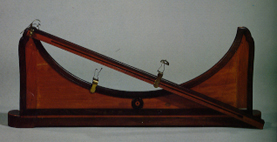
53.8 x 131.4 x 37.8
Carved wood and brass
INDEX 1788: G.II.172
Machina lignea cum variis partibus metallicis, qua descensus corporum per cycloidem, cum descensu per lineam rectam confertur.
A machine made of wood with various metallic parts by use of which the descent of the bodies through a cycloid can be compared with the descent through a straight line.
This machine is composed of two channels for two spheres to travel along. One of the channels is a straight line installed on a beam of wood with an adjustable inclination by means of a brass joint at one end. The other channel is in the form of a cycloid cut in a piece of wood and installed vertically on a wooden base with a ballast of lead for stability.
Along both channels, two bells can be installed in different positions which signal the passage of the two spheres. The spheres are released simultaneously on their respective trajectories, starting from points that are the same height above the ground, when freed by an articulated piece of brass located at the top end of each trajectory.
If the bells are placed at points where the two trajectories intersect, it may be observed that whatever the inclination of the beam, the sphere that moves along the cycloid always arrives in first place despite having to travel through a larger distance.
In order to regulate the inclination of the beam, there is a bolt which can slip into the different holes in the board of the cycloid. The device must be placed at the edge of a table.
From Colégio dos Nobres, catalogue n.º 162.
's Gravesande, Willem Jacob, Physices Elementa, Leiden, 1742, vol I, p. 454, Tab. XVII, Fig 3.
Desaguliers, Jean Théophile, A Course of Experimental Philosophy, London, 1734, vol I, p. 380, Pl.27, Fig.9.